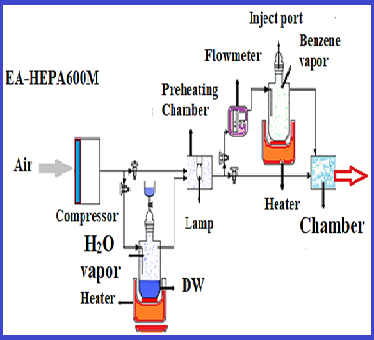Removal of benzene vapor from the air based on novel tantalum metal-organic framework (Ta-MOF) adsorbent by gas flow solid-phase interaction before determination by gas chromatography
Volume 4, Issue 04, Pages 36-48, Dec 2021 *** Field: Air pollution: Analytical Environmental Chemistry
Abstract
Benzene has a carcinogenic effect on the human body and adsorption from the air is the best way to control it. By this research, benzene vapor was removed from the air based on a tantalum metal-organic framework (Ta-MOF) by gas flow solid-phase interaction (GF-SPI). Benzene adsorption with Ta-MOF was studied in the static and dynamic systems at room temperature. The benzene concentration was analyzed by gas chromatography equipped with an FID detector (GC-FID). The factors affecting benzene removal efficiency like initial concentration of benzene, amount of adsorbent, exposure time, flow rate, and temperature were studied and optimized. The results showed us, the adsorption capacities range of Ta-MOF for benzene in the static and dynamic system were obtained between 90-160 mg g-1 and 65-135 mg g-1, respectively. Also, the high removal efficiency was achieved by more than 95% at 45°C, 67.5 mg L-1 benzene concentration, 0.5 g of Ta-MOF, and the flow rate of 250 mL min-1 for a dynamic system. By dynamic system, the benzene is generated in the chamber, stored in a bag, and then moved on the surface of Ta-MOF. The GF-SPI method was validated by GC-MS and spiking real samples.
References
G. Zhang, Y. Liu, S. Zheng, Z. Hashisho, Adsorption of volatile organic compounds onto natural porous minerals, J. Hazard. Mater., 364 (2019) 317-324. https://doi.org/10.1016/j.jhazmat.2018.10.031.
P. Liu, C. Long, Q. Li, H. Qian, A. Li, Q. Zhang, Adsorption of trichloroethylene and benzene vapors onto hypercrosslinked polymeric resin, J. Hazard. Mater., 166 (2008) 46-51. https://doi.org/10.1016/j.jhazmat.2008.10.124.
D. Loomis, K.Z. Guyton, Y. Grosse, F. El Ghissassi, V. Bouvard, L. Benbrahim-Tallaa, N. Guha, N. Vilahur, H. Mattock, K. Straif, Carcinogenicity of benzene, Lancet. Oncol, 18 (2017) 1574-1575. https://doi.org/10.1016/s1470-2045(17)30832-x.
R. Althouse, J. Huff, L. Tomatis, J. Wilbourn, Chemicals and industrial processes associated with cancer in humans. IARC Monographs, IARC. Monogr. Eval. Carcinog. Risk. Chem. Hum. Suppl., 1-20 (1979) 1-71. https://monographs.iarc.who.int/wp-content/uploads/2018/06/mono71.pdf
L.H. Xie, X. M. Liu, T. He, J. R. Li, Metal-Organic frameworks for the capture of trace aromatic volatile organic compounds, Chem., 4 (2018) 1911-1927. https://doi.org/10.1016/j.chempr.2018.05.017.
P. Gaurh, H. Pramanik, Production of benzene/toluene/ethyl benzene/xylene (BTEX) via multiphase catalytic pyrolysis of hazardous waste polyethylene using low-cost fly ash synthesized natural catalyst, Waste. Manag., 77 (2018) 114-130. https://doi.org/10.1016/j.wasman.2018.05.013.
D.M. Chambers, C.M. Reese, L.G. Thornburg, E. Sanchez, J.P. Rafson, B.C. Blount, J.R.E. Ruhl, V.R. De Jesús, Distinguishing petroleum (Crude Oil and Fuel) from smoke exposure within populations based on the relative blood levels of benzene, toluene, ethylbenzene, and xylenes (BTEX), styrene and 2,5-Dimethylfuran by pattern recognition using artificial neural networks, Environ. Sci. Technol., 52 (2018) 308-316. https://doi.org/10.1021/acs.est.7b05128.
E. Farsouni Eydi, A. Shariati, M.R. Khosravi-Nikou, Separation of BTEX compounds (benzene, toluene, ethylbenzene and xylenes) from aqueous solutions using adsorption process, J. Dispers. Sci. Technol., 40 (2019) 453-463. https://doi.org/10.1080/01932691.2018.1472007.
A.L. Bolden, C.F. Kwiatkowski, T. Colborn, New look at BTEX: Are ambient levels a problem?, Environ. Sci. Technol., 49 (2015) 5261-5276. https://doi.org/10.1021/es505316f.
M.I. Konggidinata, B. Chao, Q. Lian, R. Subramaniam, M. Zappi, D.D. Gang, Equilibrium, kinetic and thermodynamic studies for adsorption of BTEX onto ordered mesoporous carbon (OMC), J. Hazard. Mater., 336 (2017) 249-259. https://doi.org/10.1016/j.jhazmat.2017.04.073.
R. Montero-Montoya, R. López-Vargas, O. Arellano-Aguilar, Volatile organic compounds in air: sources, distribution, exposure and associated illnesses in children, Ann. Glob. Health, 84 (2018) 225-238. https://doi.org/10.29024/aogh.910.
F.A. Kuranchie, P.N. Angnunavuri, F. Attiogbe, E.N. Nerquaye-Tetteh, Occupational exposure of benzene, toluene, ethylbenzene and xylene (BTEX) to pump attendants in Ghana: Implications for policy guidance, Cogent. Environ. Sci., 5 (2019) 1603418. https://doi.org/10.1080/23311843.2019.1603418.
H. Huang, H. Huang, Q. Feng, G. Liu, Y. Zhan, M. Wu, H. Lu, Y. Shu, D.Y. Leung, Catalytic oxidation of benzene over Mn modified TiO2/ZSM-5 under vacuum UV irradiation, Appl. Catal. B, 203 (2017) 870-878. https://doi.org/10.1016/j.apcatb.2016.10.083.
W. Yang, H. Zhou, C. Zong, Y. Li, W. Jin, Study on membrane performance in vapor permeation of VOC/N2 mixtures via modified constant volume/variable pressure method, Sep. Purif. Technol., 200 (2018) 273-283. https://doi.org/10.1016/j.seppur.2018.02.044.
V. Binas, V. Stefanopoulos, G. Kiriakidis, P. Papagiannakopoulos, Photocatalytic oxidation of gaseous benzene, toluene and xylene under UV and visible irradiation over Mn-doped TiO2 nanoparticles, J. Mater., 5 (2019) 56-65. https://doi.org/10.1016/j.jmat.2018.12.003.
Y. Wang, H. Tao, D. Yu, C. Chang, Performance assessment of ordered porous electrospun honeycomb fibers for the removal of atmospheric polar volatile organic compounds, Nanomater. (Basel), 8 (2018) 350. https://doi.org/10.3390/nano8050350.
K. Yang, Q. Sun, F. Xue, D. Lin, Adsorption of volatile organic compounds by metal-organic frameworks MIL-101: influence of molecular size and shape, J. Hazard. Mater., 195 (2011) 124-131. https://doi.org/10.1016/j.jhazmat.2011.08.020.
K. Vellingiri, P. Kumar, A. Deep, K.-H. Kim, Metal-organic frameworks for the adsorption of gaseous toluene under ambient temperature and pressure, Chem. Eng. J., 307 (2017) 1116-1126. https://doi.org/10.1016/j.cej.2016.09.012.
W. Song, D. Tondeur, L. Luo, J. Li, VOC Adsorption in circulating gas fluidized bed, Adsorption, 11 (2005) 853-858. https://doi.org/10.1007/s10450-005-6035-z.
Z. Zhao, S. Wang, Y. Yang, X. Li, J. Li, Z. Li, Competitive adsorption and selectivity of benzene and water vapor on the microporous metal organic frameworks (HKUST-1), Chem. Eng. J., 259 (2015) 79-89. https://doi.org/10.1016/j.cej.2014.08.012.
S. Gwardiak, B. Szczęśniak, J. Choma, M. Jaroniec, Benzene adsorption on synthesized and commercial metal-organic frameworks, J. Porous, Mater., 26 (2018) 775-783. https://doi.org/10.1007/s10934-018-0678-0.
L.Y. Filippova, V.N. Shubina, N.P. Kozlova, S.B. Putin, Adsorption properties of the MOF-5 metal-organic framework in relation to water and benzene, Russ. J. Appl. Chem., 86 (2013) 1388-1391. https://doi.org/10.1134/S1070427213090126.
Zhou H-C, Long JR, Yaghi OM, Introduction to Metal–Organic Frameworks, Chem. Rev., 112 (2012) 673-674. https://doi.org/10.1021/cr300014x.
D. Britt, D. Tranchemontagne, O.M. Yaghi, Metal-organic frameworks with high capacity and selectivity for harmful gases, Proc. Natl. Acad. Sci., 105 (2008) 11623. https://doi.org/10.1073/pnas.0804900105.
K. Vikrant, C. J. Na, S.A. Younis, K. H. Kim, S. Kumar, Evidence for superiority of conventional adsorbents in the sorptive removal of gaseous benzene under real-world conditions: Test of activated carbon against novel metal-organic frameworks, J. Clean. Prod., 235 (2019) 1090-1102. https://doi.org/10.1073/pnas.0804900105.
D. Wu, X. Quan, Y. Zhao, S. Chen, Removal of p-xylene from an air stream in a hybrid biofilter, J. hazard. Mater., 136 (2006) 288-295. https://doi.org/10.1016/j.jhazmat.2005.12.017.
S. Pedram, H.R. Mortaheb, F. Arefi-Khonsa, Optimization of benzene removal by air gap membrane distillation using response surface methodology, J. Water Supp. Res. Technol., 68 (2019) 231-242. https://doi.org/10.2166/aqua.2019.067.
Y. Yang, P. Bai, X. Guo, Separation of xylene isomers: a review of recent advances in materials, Ind. Eng. Chem. Res., 56 (2017) 14725-14753. https://doi.org/10.1021/acs.iecr.7b03127.
Z. Vahdat Parast, H. Asilian, A. Jonidi Jafari, Adsorption of xylene from air by Natural Iranian zeolite, health. Scope, 3 (2014) e17528. https://dx.doi.org/10.17795/jhealthscope-17528.
S.T. Lim, J.H. Kim, C.Y. Lee, S. Koo, D. W. Jerng, S. Wongwises, H.S. Ahn, Mesoporous graphene adsorbents for the removal of toluene and xylene at various concentrations and its reusability, Sci. Rep., 9 (2019) 1-12. https://doi.org/10.1038/s41598-019-47100-z.
K.W. Shah, W. Li, A Review on catalytic nanomaterials for volatile organic compounds removal and their applications for healthy buildings, Nanomater. (Basel), 9 (2019) 910. https://doi.org/10.3390/nano9060910.
K. Patil, S. Jeong, H. Lim, H. S. Byun, S. Han, Removal of volatile organic compounds from air using activated carbon impregnated cellulose acetate electro spunmats, Environ. Eng. Res., 24 (2019) 600-607. https://doi.org/10.4491/eer.2018.336.
M. Bagheri Hossein Abadi, H. Shirkhanloo, J. Rakhtshah, Air pollution control: the evaluation of TerphApm@MWCNTs as a novel heterogeneous sorbent for benzene removal from air by solid phase gas extraction, Arab. J. Chem., 13 (2020) 1741-1751. https://doi.org/10.1016/j.arabjc.2018.01.011.
S. KP Veerapandian, N. De Geyter, J. M. Giraudon, J.-F. Lamonier, R. Morent, the use of zeolites for VOCs abatement by combining non-thermal plasma, adsorption, and/or catalysis: a review, Catalysts, 9 (2019) 98. https://doi.org/10.3390/catal9010098.
H. Shirkhanloo, M. Osanloo, O. Qurban-dadras, Nobel method for toluene removal from air based on ionic liquid modified nano-graphene, Int. J. Occup. Hyg., 6 (2014) 1-5. https://ijoh.tums.ac.ir/index.php/ijoh/article/view/89
M.R. Rezaei Kahkha, M. Kaykhaii, G. Sargazi, B. Rezaei Kahkha, Determination of nicotine in saliva, urine and wastewater samples using tantalum metal organic framework pipette tip micro-solid phase extraction, Anal. Methods, 11 (2019) 6168-6175. https://doi.org/10.1039/C9AY01773A.
F. Su, C. Lu, S. Hu, Adsorption of benzene, toluene, ethylbenzene and p-xylene by NaOCl-oxidized carbon nanotubes, Colloids. Surf. A. Physicochem. Eng. Asp., 353 (2010) 83-91. http://dx.doi.org/10.1016/j.colsurfa.2009.10.025.
M. Jafarizaveh, H. Shirkhanloo, F. Golbabaei, A. Tabrizi, K. Azam, M. Ghasemkhani, Nobel method for xylene removal from air on nano activated carbon adsorbent compared to NIOSH approved carbon adsorbent, J. Health Safe. Work, 6 (2016) 23-30. https://jhsw.tums.ac.ir/browse.php?a_id=5374&sid=1&slc_lang=en

Copyright (c) 2021 Analytical Methods in Environmental Chemistry Journal

This work is licensed under a Creative Commons Attribution 4.0 International License.
JOURNAL PUBLISHING AGREEMENT
PLEASE PROVIDE US THE FOLLOWING INFORMATION,
Article entitled:
Corresponding author:
To be published in the journal:
Your Status
I am the sole author of the manuscript
- I am an Iranian government employee.
- I am a European government employee
- I am a Asian government
- None of the above
I am one author signing on behalf of all co-authors of the manuscript
- I am an Iranian government employee.
- I am a European government employee
- I am a Asian government
- None of the above
Please tick the above blanks (as appropriate), review the Journal Publishing Agreement, and then sign and date the document in black ink.
Published Journal Article: the author may share a link to the formal publication through the relevant DOI. Additionally theses and dissertations which contain embedded Published Journal Articles as part of the formal submission may be hosted publicly by the awarding institution with a link to the formal publication through the relevant DOI. Any other sharing of Published Journal Articles is by agreement with the publisher only.
Signed: ______________________________________ Name printed: ___________________________________________
Title and Company (if employer representative): _______________________Date: __________________________________














